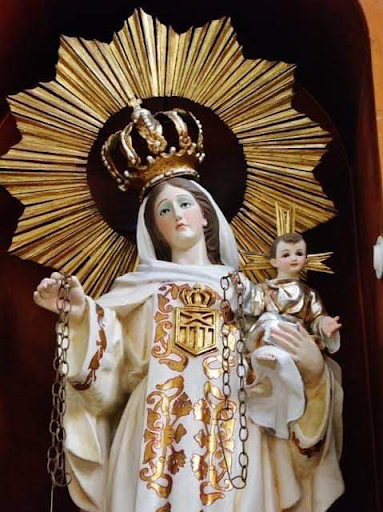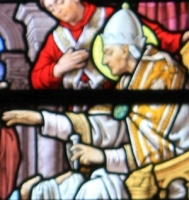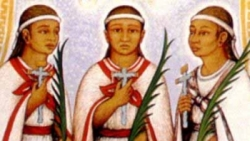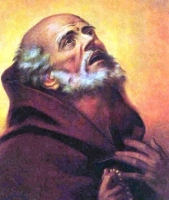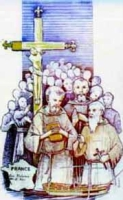St. Chuniald & Gislar
Feastday: September 24
Death: 7th century
Irish or Scottish missionaries to southern Germany and Austria. They labored as disciples of St. Rupert of Salzburg
He was one of those eminent Scottish or Irish missionaries who left their native country to carry the faith of Christ into Germany. He was for many years the constant companion of St. Rupert[a], bishop of Saltzburg, in all his apostolical functions. He is mentioned in some Martyrologies on the 27th of February, but his feast is kept on the 24th of September, the day of the translation of his relics. See Colgan, Act. SS. p. 769
St. Rupert of Salzberg
Feastday: September 24 ,March 27
Possibly descended from the Merovingians and claimed by the Irish as one of their own, St. Rupert of Salzburg was bishop of Worms when Childeric III asked that he evangelize Bavaria. Rupert travelled from Ratisbon to the Danube, where he converted Duke Theodo II. The duke gave him land at Iuvavum, on which Rupert established the abbey of St. Peter and the Nonnberg convent. Its abbess was his niece, Erendruda. Rupert also converted pagan temples into Christian churches and established the salt-mining industry from which the city takes its present name, Salzburg. When Rupert died c. 710/717, he was buried in St. Peter's abbey. Vergil of Salzberg later translated his relics to the cathedral in Salzberg.
Rupert of Salzburg (German: Ruprecht,[a] Latin: Robertus, Rupertus; c. 660[b] – 710 AD) was Bishop of Worms as well as the first Bishop of Salzburg and abbot of St. Peter's in Salzburg. He was a contemporary of the Frankish king Childebert III.[2] Rupert is venerated as a saint in the Roman Catholic and Eastern Orthodox Churches.[3] Rupert is also patron saint of the Austrian state of Salzburg.
Blessed Anton Martin Slomsek
Also known as
Anton Martin Slomshek
Profile
Born to a peasant family in the Austro-Hungarian Empire. Seminarian at Klagenfurt, Austria. Ordained on 8 September 1824. Parish priest for five years. Spiritual director of the Klagenfurt seminary. Taught the Slovene language to seminarians; because the rulers of the empire spoke German, Slovenian was in danger of disappearing. Prince-bishop of Lavant, Austria (modern Maribor, Slovenia) on 30 May 1846, a diocese with a Slovene majority.
Bishop Slomsek began a campaign of patriotic education. He built new schools, encouraged Slovenian language and culture, wrote textbooks, and edited others. He founded a weekly newspaper, and published his sermons and episcopal statements. Founded the Saint Hermagoras Society publishing house to publish popular works in Slovenian. Today the region is nearly 100% literate, much of it due to Bishop Anton's good work.
Born
26 November 1800 in Ponikva pri Zalcu, Savinjska, Slovenia
Died
24 September 1862 in Maribor, Podravska, Slovenia of natural causes
Beatified
• 19 September 1999 by Pope John Paul II at Maribor, Slovenia
• the first beatified Slovene
Our Lady of Walsingham
Also known as
Virgin by the Sea
Profile
In 1061 Lady Richeldis de Faverches, lady of the manor near the village of Walsingham, Norfolk, England, was taken in spirit to Nazareth. There Our Lady asked her to build a replica, in Norfolk, of the Holy House where she had been born, grew up, and received the Annunciation of Christ's impending birth. She immediately did, constructing a house 23'6" by 12'10" according to the plan given her. Its fame slowly spread, and in 1150 a group of Augustinian Canons built a priory beside it. Its fame continued to grow, and for centuries it was a point of pilgrimage for all classes, the recipient of many expensive gifts.
In 1534 Walsingham became one of the first houses to sign the Oath of Supremacy, recognizing Henry VIII as head of the Church in England. Dissenters were executed, and in 1538 the House was stripped of its valuables, its statue of the Virgin taken to London, England to be burned, its buildings used as farm sheds for the next three centuries.
In 1896 Charlotte Boyd purchased the old Slipper Chapel and donated it to Downside Abbey. In 1897 Pope Leo XIII re-founded the ancient shrine of Our Lady of Walsingham, and pilgrimages were permitted to resume. The statue of Our Lady was re-enshrined in 1922, beginning an era of cooperation at the shrine between Catholics and Anglicans. In 1981 construction began on the Chapel of Reconciliation, a cooperative effort between the two confessions, and located near the shrine. The feast of Our Lady of Walsingham was reinstated in 2000. In 2012 the Personal Ordinariate of the Chair of Saint Peter for Anglicans joining the Church was given its patron as the Blessed Virgin Mary under the title Our Lady of Walsingham.
Patronage
• England
• East Anglia, England, diocese of
• Personal Ordinariate of the Chair of Saint Peter
Feast of Our Lady of Mercy
இரக்கத்தின்_அன்னை
பதின்மூன்றாம் நூற்றாண்டில் ஸ்பெயின் நாட்டில் பிறந்தவர் புனித பீட்டர் நோலாஸ்கா.
மிகப்பெரிய செல்வந்தரான இவர், மூர் இனத்தவரால் ஆப்பிரிக்கச் சிறைகளில் அடைத்து வைக்கப்பட்டு, கடுமையாகச் சித்திரவதை செய்யப்பட்ட கிறிஸ்தவர்களை எப்படியாவது மீட்கவேண்டும் என்று முடிவுசெய்தார். அதற்காகத் தன் சொத்துக்களையெல்லாம் விற்றார்.
இவருடைய இந்த முயற்சிக்கு ஸ்பெயின் நாட்டில் உள்ள அரகோனை ஆண்டுவந்த முதலாம் ஜேம்ஸ் என்ற மன்னரும், பெனபோர்ட் நகர்ப் புனித ரெய்மெண்டும் பெரிதும் உதவினர்.
இவர்களுடைய உதவியினால் புனித பீட்டர் நோலாஸ்கா, மூர் இனத்தவரிடம் அடிமைகளாக இருந்த கிறிஸ்தவர்களை மீட்க முயற்சி செய்துகொண்டிருக்கும்போதுதான், அன்னை மரியா இவருக்கு இரண்டு பைகள் நிறைய தங்கக் காசுகளோடு தோன்றினார்.
தங்கக் காசுகள் இருந்த அந்த இரண்டு பைகளையும் புனித பீட்டர் நோலாஸ்காவிடம் கொடுத்த அன்னை மரியா, இவற்றைக் கொண்டு மூர் இனத்தவரிடம் அடிமைகளாக இருக்கும் கிறிஸ்தவர்களை மீட்டு வா என்றார். கூடவே அவரோடு சேர்ந்து பணிபுரியக்கூடியவர்கள் அணியவேண்டிய வெந்நிற ஆடையையும் கொடுத்துவிட்டு அங்கிருந்து மறைந்தார்.
இவ்வாறு அன்னை மரியா, புனித பீட்டர் நோலாஸ்காவிற்குத் தோன்றிய நாள் 1281 ஆம் ஆண்டு, ஆகஸ்ட் திங்கள் 1.
Also known as
• Nuestra Señora de la Merced
• Our Lady of Ransom
Article
Commemorates the foundation of the Mercedarian Order and the apparition of Our Lady of Ransom. In this appearance she carried two bags of coins for use in ransoming Christians imprisoned by Moors. On 10 August 1218, the Mercedarian Order was legally constituted at Barcelona, Spain by King James of Aragon, and was approved by Pope Gregory IX on 17 January 1235. The Mercedarians celebrated their institution on the Sunday nearest to 1 August because it was on 1 August 1218 that the Blessed Virgin showed Saint Peter Nolasco the white habit of the Order. This custom was approved by the Congregation of Rites on 4 April 1615. On 22 February 1696 it was extended to the entire Latin Church, and the date changed to 24 September.
Patronage
• Bahía Blanca, Argentina, archdiocese of
• Barcelona, Spain
• Dominican Republic
Blessed José Ramón Ferragud Girbes
Profile
Baptized at the age of two days at his parish church of Saint James the Apostle. Lifelong layman in the archdiocese of Valencia, Spain. Married on 21 January 1914 to Josefa Borras Borras. Father of eight children. Attended daily Mass, and was active in the lay apostolates in his parish including the Union of Catholic Workers, serving as a catechist, writing about the conditions of Christians in Spain, and standing guard to protect churches. Arrested several times by anti–Catholic miitia men, and eventually martyred in the Spanish Civil War. He died shouting “Viva Christo Rey!” (Long live Christ the King!)
Born
10 October 1887 in Algemesí, Valencia, Spain
Died
shot on 24 September 1936 in Alzira, Valencia, Spain
Beatified
11 March 2001 by Pope John Paul II
Blessed William Spenser
Additional Memorial
• 29 October as one of the Martyrs of Douai
• 22 November as one of the Martyrs of England, Scotland, and Wales
Profile
Raised in an Anglican family. Studied at Trinity College, Oxford, England but left in 1580 and joined the Catholic Church in 1582. Studied at the seminary in Reims, France. Ordained as a priest in the apostolic vicariate of England on 24 September 1583. Father William returned to England to ministery to covert Catholics on 29 August 1584 where he brought his family to the Church. For a while Blessed Robert Hardesty hid and supported him. William turned himself in to authorities in York for the crime of being a priest in England so he could minister to other prisoners. Martyr.
Born
c.1555 in Gisburn, Lancashire, England
Died
hanged on 24 September 1589 in York, North Yorkshire, England
Beatified
22 November 1987 by Pope John Paul II
Saint Gerard Sagredo
புனித ஜெரார்ட் சார்கிரேடோ
St. Gerard Sargredo
நினைவுத் திருநாள்: செப்டம்பர் 24
பிறப்பு : 980
இறப்பு : 24 செப்டம்பர் 1046
புனிதர்பட்டம் : 1083, திருத்தந்தை 7 ஆம் கிரகோரி
பாதுகாவல் : ஹங்கேரி, புடாபெஸ்ட் நாடு
இவர் கசானாட் (Csanad) என்ற மறைமாவட்டத்தில் ஆயராக இருந்தார். வெனிஸ் நகர் ஆயர் ஹங்கேரி நாட்டு அரசருக்கு பலவிதங்களில் உதவினார். அதனால் புனித ஜெரார்ட் வெனிஸ் நகர ஆயருக்கு மறைமாவட்டத்திற்கு தேவையான உதவிகளை செய்து கொடுத்தார். பின்னர் ஹங்கேரி நாட்டு அரசர் புனித ஸ்டீபனின் மகன் வெனிஸ் நகர் பல்கலைக்கழகத்தில் படிக்கும்போது, அவருக்கும், படிப்பிற்கு தேவையான உதவிகளை செய்து கொடுத்தார். ஹங்கேரி நாட்டில் கிறிஸ்தவம் வளர்வதற்கு அந்நாட்டு அரசர் புனித ஸ்டீபனிற்கும் பெரும் உதவியாளராக இருந்தார்.
இவர் ஹங்கேரியில் மலைப்பகுதியில் செல்லும்போது, அவர் சென்ற இரு சக்கர வண்டி கீழே சரிந்ததில், மலை உச்சியிலிருந்து விழுந்துள்ளார். அவர் கீழே பாதாளத்தில் விழுந்ததும் இறந்துவிட்டார் போல காணப்பட்டார். ஆனால் அவரின் உடலில் சிறிதும் அடிபடாமல் தன் கைகளை கூப்பி, தான் இறப்பதற்காக செபித்துள்ளார் என்று கூறப்படுகின்றது. இவர் இறந்தப்பிறகு அம்மலையானது கில்லர்ட் ஹில் (Gillert Hill) என்று பெயரிட்டு அழைக்கப்படுகின்றது. இவர் இறக்கும் வரை வெனிஸ் மற்றும் ஹங்கேரி நாட்டு மக்களுக்காக பெரிதும் உழைத்து மறைப்பணியை ஆற்றியுள்ளார்.
Also known as
• Apostle of Hungary
• Gerard of Hungary
• Collert, Gerardo, Gellért
Profile
Benedictine monk. Abbot at San Giorgio Maggiore abbey, Venice, Italy. He passed through Hungary while on a pilgrimage to Palestine. There he met with King Saint Stephen who persuaded him to stay and minister to the Magyars. Tutor of Prince Saint Emeric. First bishop of Csanad, Hungary in 1035. Martyred during the pagan backlash that followed the death of Saint Stephen.
Born
23 April 980 in Venice, Italy
Died
• stabbed to death with a lance on 24 September 1046 at Buda, Hungary
• body thrown into the Danube River
• surviving relics enshrined in the Basilica of San Donato in Murano, Venice, Italy
Canonized
1083 by Pope Saint Gregory VII
Patronage
Hungary
Blessed Encarnación Gil Valls
Profile
Lay woman in the archdiocese of Valencia, Spain. Baptized on the day of her birth, she was confirmed at age 5 and made her first Communion at 11, all in her parish church of Santa Maria. She considered religious life, but realized a vocation of helping her brother who as a parish priest. Taught elementary school. Member of Catholic Action the Daughters of Mary, a catechist, she was devoted to Eucharistic adoration. Martyred in the Spanish Civil War.
Born
27 January 1888 in Ontinyent, Valencia, Spain
Died
shot on the night of 24 September 1936 at the port of L'Ollería, Valencia, Spain
Beatified
11 March 2001 by Pope John Paul II
Saint Pacificus of San Severino
சான் செவரினோ நகர் புனிதர் பஸிஃபிகஸ்
குரு:
(Priest)
பிறப்பு: மார்ச் 1, 1653
சான் செவரினோ, மேக்கராடா, திருத்தந்தையர் மாநிலங்கள்
(San Severino, Macerata, Papal States)
இறப்பு: செப்டம்பர் 24, 1721 (வயது 68)
சான் செவரினோ, மேக்கராடா, திருத்தந்தையர் மாநிலங்கள்
(San Severino, Macerata, Papal States)
ஏற்கும் சமயம்:
ரோமன் கத்தோலிக்க திருச்சபை
(Roman Catholic Church)
முக்திபேறு பட்டம்: ஆகஸ்ட் 4, 1786
திருத்தந்தை ஆறாம் பயஸ்
(Pope Pius VI)
புனிதர் பட்டம்: மே 26, 1839
திருத்தந்தை பதினாறாம் கிரகோரி
(Pope Gregory XVI)
நினைவுத் திருநாள்: செப்டம்பர் 24
புனிதர் பஸிஃபிகஸ், ஒரு இத்தாலி நாட்டைச் சேர்ந்த ரோமன் கத்தோலிக்க திருச்சபையின் குரு ஆவார். இவர், தாம் நிகழ்த்திய அற்புதங்களின்பேரில் பிரபலமானவர்.
“கார்லோ அன்டோனியோ டிவைனி” (Carlo Antonio Divini) எனும் இயற்பெயர் கொண்ட இவர், கி.பி. 1653ம் ஆண்டு, மார்ச் மாதம், முதலாம் தேதியன்று, “சான் செவரினோ” (San Severino) எனுமிடத்தில் பிறந்தார். “அன்டோனியோ மரியா டிவைனி” (Antonio Maria Divini) இவரது தந்தை ஆவார். இவரது தாயாரின் பெயர், “மரியேஞ்சலா புரூனி” (Mariangela Bruni) ஆகும். மூன்று வயதான இவர் உறுதிப்பூசுதல் அருட்சாதனம் பெற்றதும், இவருடைய பெற்றோர் மரித்துப் போயினர். கி.பி. 1670ம் ஆண்டும், டிசம்பர் மாதம் வரை, இவர் மிகுந்த கஷ்டங்கள் அனுபவித்தார். பின்னர், “மார்ச் அன்கோனா” (March of Ancona) நகரிலுள்ள சீர்திருத்தப்பட்ட ஃபிரான்சிஸ்கன் சபையில் இணைந்து அதன் சீருடைகளைப் பெற்றார்.
மிகுந்த கஷ்டங்களினூடே படித்த இவர், கி.பி. 1678ம் ஆண்டு, ஜூன் மாதம், 4ம் தேதியன்று, குருத்துவ அருட்பொழிவு பெற்றார். 1680ம் ஆண்டு முதல், 1683ம் ஆண்டு வரையான காலத்தில், தமது சபையின் புதிய உறுப்பினர்களுக்கு தத்துவ பாடம் கற்பிக்கும் பேராசிரியர் பணியாற்றினார். இதைத் தொடர்ந்து நான்கு அல்லது ஐந்து ஆண்டுகளுக்கு ஒரு மிஷனரியாக சுற்றியிருந்த பகுதிகளில் மறைபணிபுரிந்தார். ஆனால், அதனைத் தொடர்ந்து ஏற்பட்ட நடை தடுமாற்றம் (Lameness), செவிட்டுத் தன்மை (Deafness) மற்றும் கண்பார்வைக் குறைபாடு (Blindness) போன்றவற்றினால் அவரால் தொடர்ந்து மறைப் பணியாற்ற இயலாமல் போனது. பின்னர் அவர், அவர் தியான வாழ்க்கையை தொடங்கினார். அவரது வாழ்நாள் முழுவதும் ஆழ்ந்த உடல் வேதனைகள் தொடர்ந்தாலும், அவர் கடவுளிடம் மட்டுமே ஆறுதலையும் நிவாரணத்தையும் தேடிக்கொண்டிருந்தார். அதிசயமான இயற்கை சக்திகள் மற்றும் உழைக்கும் அற்புதங்களின் பரிசுகள் அவருக்கு கடவுளால் வழங்கப்பட்டிருந்தன. அவர், ஒரு தேவதூதனின் பொறுமையுடன் நோய்களின் வேதனைகளைத் தாங்கிக் கொண்டு, பல அற்புதங்களைச் செய்தார். மென்மேலும் கடவுளால் ஆசீர்வதிக்கப்பட்டார்.
இவர் ஒரு நிலையான நோயாளியாக இருந்தபோதிலும், கி.பி. 1692ம் ஆண்டு முதல் 1693ம் ஆண்டுவரை, "சான் சவரினோ" (San Severino) நகரிலுள்ள "சான்ட மரியா டெல் கிரேஸி" கான்வென்ட்டில் (Convent of Santa Maria delle Grazie) பாதுகாவலர் பதவியை வகித்தார். பின்னர், அங்கேயே கி.பி. 1721ம் ஆண்டு, செப்டம்பர் மாதம், 24ம் நாளன்று, மரித்தார்
Profile
Son of Antonio M Divini and Mariangela Bruni, both of whom died when Pacificus was about 3 years old, leaving him to be raised by an uncle. Joined the Franciscans in December 1670. Ordained in 1678. Professor of philosophy, teaching novices. Parish mission preacher. His health failed and he spent his final 29 years lame, deaf and blind, leading a contemplative life. Received visions and ecstasies. Miracle worker.
Born
1 March 1653 at San Severino, Italy
Died
24 September 1721 at San Severino, Italy
Beatified
4 August 1786 by Pope Pius VI
Canonized
26 May 1839 by Pope Gregory IX
Saint Terence of Pesaro
Also known as
Terenzio
Profile
Fled to across the Adriatic Sea Italy to escape persecutions in Pannonia (modern Hungary in the early 3rd century. Bishop of Pesaro, Italy. Martyr.
Born
c.210 in Pannonia (modern Hungary)
Died
• 24 September 247 at Pesaro, Italy
• relics enshrined in the cathedral of Pesaro
Patronage
Pesaro, Italy
Representation
• young soldier holding a palm and a red and white flag
• young soldier holding the city of Pesaro, Italy
Saint Isarnus of Toulouse
Also known as
• Isarnus of Marseille
• Isarno of...
• Ysarn of...
Profile
Educated at Saint Victor's, Marseilles, France. Benedictine monk at Saint Victor's. As abbot at Saint Victor's he revitalized spiritual life and devotion to the Rule; his house became the center of a great Benedictine revival in the region. Famous for his charity and his prison ministry. Secured the release of the monks of the Lérins Abbey when it was captured by Saracens.
Born
at Marseilles, Provence (in modern France)
Died
1048 at Marseilles, Provence (in modern France)
Blessed Colomba Matylda Gabriel
Also known as
Janina Matylda Gabriel
Profile
Founder of the Benedettine di Caritá (Benedictine Sisters of Charity).
Born
3 May 1858 at Ivano-Frankivsk, Poland (now in Ukraine) as Janina Matylda Gabriel
Died
24 September 1926 at Rome, Italy of natural causes
Beatified
16 May 1993 by Pope John Paul II
Saint Anathalon of Milan
Also known as
Anatalone, Anatelon, Anatalo, Anatolo, Anatolio, Anatalofle, Anatelofl, Anatolofle
Profile
Spiritual student of Saint Barnabas the Apostle. First-century bishop of Milan, Italy, assigned by Saint Barnabas. Evangelized the entire region.
Died
Brescia, Italy
Blessed Robert Hardesty
Additional Memorial
22 November as one of the Martyrs of England, Scotland, and Wales
Profile
Layman, martyred for the crime of hiding and supporting the work of Blessed William Spenser.
Born
Yorkshire, England
Died
hanged on 24 September 1589 in York, North Yorkshire, England
Beatified
22 November 1987 by Pope John Paul II
Saint Antonio González
Profile
Dominican priest. Missionary to Japan. Martyr.
Born
1593 in León, Spain
Died
24 September 1637 at Nagasaki, Japan
Canonized
18 October 1987 by Pope John Paul II
Saint Coprio
Profile
Abandoned as an infant on a dungheap (Greek: koprìa) by his parents, the boy was found and rescued by monks of the nearby monastery of Saint Theodosius in Bethleham. The monks named him Coprio, and raised him as their own. He grew become a model of holiness, living his 90 years in the monastery. Monk.
Saint Paphnutius of Egypt
Profile
Hermit. During the persecutions of Diocletian, Paphnutius came out of the wilderness to stand with his fellow Christians. Martyr.
Died
tortured on a rack then hanged from a palm tree in 303 in Egypt
Saint Ysarn of Saint Victor
Profile
Benedictine monk and then abbot of Saint Victor Abbey in Marseilles, France, which flourished under him.
Born
Toulouse, France
Died
1048
Saint Andochius of Autun
Profile
Second-century priest in Smyrna. Missionary in the area of Autun in Gaul (modern France), assigned by Saint Polycarp. Martyr.
Died
179
Saint Thyrsus of Autun
Profile
Second-century deacon in Smryna. Missionary in the area of Autun in Gaul (modern France), assigned by Saint Polycarp. Martyr.
Died
179
Saint Lupus of Lyons
Profile
Monk near Lyons, France. Archbishop of Lyons. Suffered in the turmoil which followed the death of Saint Sigismund of Burgundy.
Died
542
Saint Felix of Autun
Profile
Rich, second-century merchant in Autun, France. Convert. Assisted and supported missionaries in his region. Martyr.
Died
179
Saint Rusticus of Clermont
Also known as
Rotiri
Profile
Bishop of Clermont, France from 426 to 446.
Died
446
Saint Erinhard
Profile
Monk. Prior.
Born
Normandy, France
Died
739 in the diocese of Fontenelle, France
Martyrs of Chalcedon
Profile
Forty-nine Christian choir singers of the church in Chalcedon in Asia Minor who were martyred together in their persecutions of Diocletian.
Died
304
Martyred in the Spanish Civil War
Thousands of people were murdered in the anti-Catholic persecutions of the Spanish Civil War from 1934 to 1939. I have pages on each of them, but in most cases I have only found very minimal information. They are available on the CatholicSaints.Info site through these links:
• Blessed Antonio Pancorbo López
• Blessed Esteban García y García
• Blessed José María Ferrándiz Hernández
• Blessed Juan Francisco Joya Corralero
• Blessed Luis de Erdoiza Zamalloa
• Blessed Manuel Gómez Contioso
• Blessed Melchor Rodríguez Villastrigo
• Blessed Pascual Ferrer Botella
• Blessed Rafael Rodríguez Mesa
• Blessed Santiago Arriaga Arrien
Also celebrated but no entry yet
• Our Lady of Val Camonica
• Dalmazio Moner
• Robert of Knaresborough
• Wolfgang of Steinkirchen



